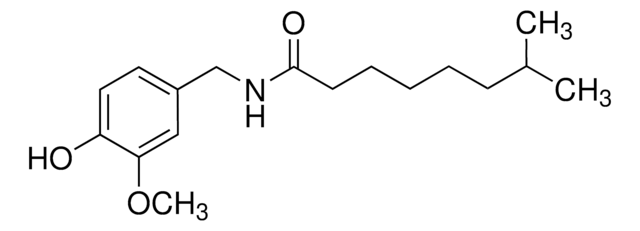360376
Capsaicin
63.7% (HPLC), powder, TRPV1 agonist
Synonym(s):
8-Methyl-N-vanillyl-trans-6-nonenamide
About This Item
Recommended Products
product name
Capsaicin, natural
grade
natural
Assay
63.7% (HPLC)
form
powder
composition
capsaicin, 65%
dihydrocapsaicin, 35%
mp
62-65 °C (lit.)
solubility
chloroform: 5%
storage temp.
2-8°C
SMILES string
COc1cc(CNC(=O)CCCC\C=C\C(C)C)ccc1O
InChI
1S/C18H27NO3/c1-14(2)8-6-4-5-7-9-18(21)19-13-15-10-11-16(20)17(12-15)22-3/h6,8,10-12,14,20H,4-5,7,9,13H2,1-3H3,(H,19,21)/b8-6+
InChI key
YKPUWZUDDOIDPM-SOFGYWHQSA-N
Gene Information
human ... CYP1A2(1544) , TRPV1(7442)
rat ... Trpv1(83810) , Trpv4(66026)
Looking for similar products? Visit Product Comparison Guide
General description
Application
Biochem/physiol Actions
Signal Word
Danger
Hazard Statements
Precautionary Statements
Hazard Classifications
Acute Tox. 2 Oral - Eye Dam. 1 - Resp. Sens. 1 - Skin Irrit. 2 - Skin Sens. 1 - STOT SE 3
Target Organs
Respiratory system
Storage Class Code
6.1A - Combustible acute toxic Cat. 1 and 2 / very toxic hazardous materials
WGK
WGK 3
Flash Point(F)
235.4 °F - closed cup
Flash Point(C)
113 °C - closed cup
Personal Protective Equipment
Certificates of Analysis (COA)
Search for Certificates of Analysis (COA) by entering the products Lot/Batch Number. Lot and Batch Numbers can be found on a product’s label following the words ‘Lot’ or ‘Batch’.
Already Own This Product?
Find documentation for the products that you have recently purchased in the Document Library.
Customers Also Viewed
Articles
Palladacyclic catalysts by Bedford's group facilitate coupling reactions with low catalyst loadings and challenging aryl chlorides.
Palladacyclic catalysts by Bedford's group facilitate coupling reactions with low catalyst loadings and challenging aryl chlorides.
Palladacyclic catalysts by Bedford's group facilitate coupling reactions with low catalyst loadings and challenging aryl chlorides.
Palladacyclic catalysts by Bedford's group facilitate coupling reactions with low catalyst loadings and challenging aryl chlorides.
Our team of scientists has experience in all areas of research including Life Science, Material Science, Chemical Synthesis, Chromatography, Analytical and many others.
Contact Technical Service








